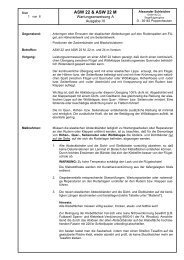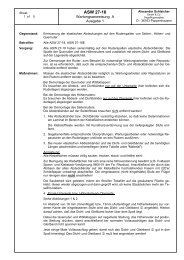Sheet - Alexander Schleicher
Sheet - Alexander Schleicher
Sheet - Alexander Schleicher
Create successful ePaper yourself
Turn your PDF publications into a flip-book with our unique Google optimized e-Paper software.
<strong>Sheet</strong>: 1 of 4<br />
Maintenance Instruction<br />
PAINT CRACKS<br />
Subject: Paint cracks on fiber composite gliders.<br />
<strong>Alexander</strong> <strong>Schleicher</strong><br />
GmbH & Co.<br />
Segelflugzeugbau<br />
D-36163 Poppenhausen<br />
Types affected: ASW 12, ASW 15, ASW 17, ASW 19, ASW 20, ASK 21, ASW 22,<br />
ASK 23, ASW 24, ASH 25; ALL variants and all serial no.s.<br />
Compliance: 1. If deep cracks which go down to the fiber composite structure, are<br />
found on the glider, the glider must be presented each year to the<br />
manufacturer or any other licensed aviation station, who upon examination<br />
of the glider decides whether the glider can be continued<br />
in service for 1 year more or whether the repair must be done<br />
at once (see point "Action A.").<br />
2. If hairline cracks which run only in the paint surface, are found on<br />
the glider, the glider shall be presented at the latest after three<br />
years annually to the manufacturer or any other licensed aviation<br />
station, who upon examination of the glider decides whether the<br />
glider can be continued in service for 1 year more or whether the<br />
repair must be done at once (see point "Action B."). The 3 years<br />
extension applies only on the condition that the maintenance and<br />
care of the aircraft is no longer neglected during this period of<br />
time and that the gliders are no longer stored outside;<br />
Reason: The Flight and Maintenance Manuals for SCHLEICHER-gliders contain<br />
insistent notes concerning the detrimental influence of moisture<br />
and sun radiation on the aerodynamic paint surface quality standard.<br />
Herewith we point out emphatically once again that every owner is<br />
obliged to observe the flight and maintenance or operations manuals<br />
of his glider in all points, and this refers also to the relevant notes on<br />
the care and maintenance of the glider.<br />
If these notes are contravened, the result will be sooner or later - depending<br />
on the climate - damage to the paint surface quality.<br />
Influence of the two factors<br />
moisture and UV-radiation:<br />
To begin with, generally an enlargement of the waviness of the finish<br />
develops - mainly on the wing and tail unit skins - caused by penetration<br />
of moisture. On the occasion of performance measurements (accomplished<br />
by P.Bickle, R.Johnson and the German DFVLR/Idaflieg)<br />
it has been demonstrated repeatedly that the larger waviness leads<br />
already to considerable performance loss which is all distinctly noticed<br />
in competitions.
<strong>Sheet</strong>: 2 of 4<br />
Maintenance Instruction<br />
PAINT CRACKS<br />
<strong>Alexander</strong> <strong>Schleicher</strong><br />
GmbH & Co.<br />
Segelflugzeugbau<br />
D-36163 Poppenhausen<br />
A competition pilot will always be anxious to preserve or restore the<br />
performance of his glider to its full extent, but unfortunately owners of<br />
training and instruction gliders are generally of the opinion that they<br />
may accept such a performance loss with those gliders. This is regrettable<br />
in the view of the manufacturer because he makes all efforts to<br />
build and supply also these gliders with a clean aerodynamic surface.<br />
The valuable production time used to this end is then possibly uselessly<br />
provided.<br />
Owing to the UV-radiation the gel coat of the paint surfaces grows<br />
brittle and shrinks; at the same time the UV-light destroys paint ingredients.<br />
So moisture (rain, dew) working in on long term will wash the<br />
decomposed paint ingredients out off the paint. The paint starts chalking<br />
and gets hairline cracks owing to the concurrence of embrittlement<br />
and shrinkage. Furthermore, these hairline cracks gather dirt<br />
which through its aggressive effect and its stronger heating-up from<br />
sun radiation further precipitates the degradation of the paint. Owing<br />
to this the intended protective effect for the fiber composite structure<br />
against moisture and UV-radiation is no longer granted.<br />
Certainly a good care with hard wax can slow down the above process<br />
distinctly, but it cannot be stopped completely. For this reason a<br />
repainting of the aircraft will always become necessary at some point<br />
of time.<br />
However, we point out explicitly that paint cracks - even deep cracks -<br />
do not represent damages to the aircraft structure if as of their first<br />
appearance immediate correct maintenance and care is given furthermore<br />
to the aircraft.<br />
As all the outside skin of the aircraft is dimensioned for stiffness, there<br />
are no critical mechanical strength problems, even if some cracks<br />
have gone down into the fiber composite structure and have already<br />
attacked the resin matrix base.<br />
The unknown ageing effects caused by the influence of moisture and<br />
UV on the unprotected fiber composite structure are more dangerous.<br />
Those paint cracks as reported from customers in USA and Australia<br />
do not appear here in Europe or they develop so much more slowly<br />
that a paint crack repair has never yet been carried out here at our<br />
works. Accordingly we have no experience of our own with such repairs.<br />
In this connection we point out expressly that for the mentioned cases<br />
in the USA or Australia an absolute "zero" care of the gliders in question<br />
added to the "climate" factor; besides these gliders were exposed<br />
to the weather almost continuously and without any particular protection<br />
- very often day and night.
<strong>Sheet</strong>: 3 of 4<br />
Maintenance Instruction<br />
PAINT CRACKS<br />
<strong>Alexander</strong> <strong>Schleicher</strong><br />
GmbH & Co.<br />
Segelflugzeugbau<br />
D-36163 Poppenhausen<br />
Action: To repair the paint cracks, these have to be removed generally by<br />
sanding them down to their ground. But in doing so, the fiber composite<br />
structure lieing under the gel coat should not be sanded on. Thus<br />
the sanding job is difficult and, therefore, relatively expensive.<br />
A. If deep cracks are concerned which go down to or into the fiber<br />
composite structure (it is assumed that they result from large and<br />
rapid temperature changes as found e.g. with wave flights !), and<br />
if a repair is decided to be necessary, the paint material has to be<br />
sanded down to the fiber composite structure carefully and the<br />
area affected must be repaired.<br />
In case that the resin matrix base of the fiber composite structure<br />
is already damaged, one should consider peeling off and replacing<br />
the damaged fiber composite layer. This work is possibly easier<br />
than the careful sanding job.<br />
B. If hairline cracks are concerned which run only in the paint surface<br />
(and which presumably result from bad maintenance together<br />
with continuous UV-radiation - i.e. gliders left outside without<br />
any protection for a long period of time), we recommend to<br />
remove the paint material from all areas attacked by sanding on<br />
them down their end and to repaint these areas. The sooner this<br />
measure is taken, the less the work expenditure.<br />
On the subject of rebuilding the paint system with materials available<br />
in the USA as well as on the subject of how to rebuild the profile<br />
(which is a must for high performance gliders which are to be flown in<br />
competitions) R.H.Johnson, Dallas Soaring Association, has written<br />
several articles published in SOARING magazine. We advise to consider<br />
in any case the repair experience accumulated in the USA.<br />
For Europe we suggest to spray the sanded surfaces first with polyester<br />
fillers, to sand them again, and to re-spray them finally thinly with a<br />
white paint system on a Polyurethane basis which should be aircraftapproved.<br />
Material and<br />
drawings: See chapter „Action“.<br />
Weight (Mass)<br />
and Balance: It is necessary to redetermine the mass and C.G. data after repaintings.<br />
After repainting of control surfaces and flaps special attention must<br />
be paid to their tailheavy balance moments; these data are given<br />
in the respective Maintenance (or Operations) Manuals of the gliders.
<strong>Sheet</strong>: 4 of 4<br />
Maintenance Instruction<br />
PAINT CRACKS<br />
<strong>Alexander</strong> <strong>Schleicher</strong><br />
GmbH & Co.<br />
Segelflugzeugbau<br />
D-36163 Poppenhausen<br />
If in the case of older glider models such data are not contained in the<br />
manuals, then the mass of the control surfaces and their tailheavy<br />
static balance moment must be determined prior to the paint job and<br />
must be readjusted after the repainting by ± 5 %.<br />
Notes: 1. The action as per this Maintenance Instruction must only by accomplished<br />
by the manufacturer or by a technical aviation service<br />
station holding an appropriate license.<br />
2. The present Maintenance Instruction PAINT CRACKS dated<br />
June 26, 1989, supersedes the previous Maintenance Instruction<br />
dated 15.07.87.<br />
Poppenhausen, June 26, 1989<br />
<strong>Alexander</strong> <strong>Schleicher</strong><br />
GmbH & Co.<br />
Gerhard Waibel<br />
The translation into English has been done by best knowledge and judgement; in any case<br />
of doubt the German original is controlling.



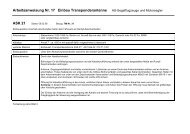


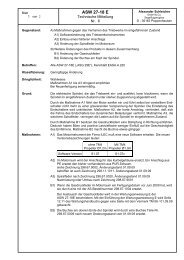
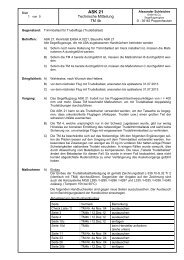
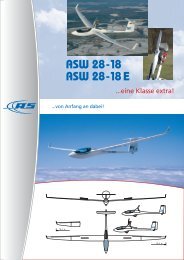



![AD 2012-0246 [PAD 12-122 task 2012.251] Schleicher-Ka6 K7 K8 ...](https://img.yumpu.com/8336662/1/184x260/ad-2012-0246-pad-12-122-task-2012251-schleicher-ka6-k7-k8-.jpg?quality=85)


